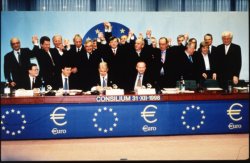
The European Integration |
The Origins of European Integration |
A-D
E-H
I-Z
Economic and Monetary Union
Education and Cultural Policy Employment Policy Energy Policy Enterprise Policy Environmental Policy Fisheries Policy |
| EU Institutions | ||
| The Decision Making Process | ||
| EU Policies: from A to Z | ||
| The EU in the World | ||
Economic and Monetary Union
From the outset, economic progress has been at the heart of the
EU’s goals. Many of the EU’s defining projects such as the Single Market or EMU
have sprung from economic policy. Equally, it is often the EU’s economic
policies which are felt on the ground, whether through support for regional
development schemes or Euro coins from 2002. The range of EU economic measures is such that they are now inextricably linked to domestic economic policy in every Member State. This is most obviously the case for those countries whose currencies adopted the Euro on 1 January 1999, and for those whose economies have benefited most from the Structural Funds. Customs UnionCustoms Union was the core of the 1957 Treaty of Rome. There are no tariffs imposed between EU Member States; they share a common customs frontier; and there is a common commercial policy for imports into the bloc (customs duties, quotas etc). The Single MarketThe 1985 Single European Act set in motion the process of completing a Single Market in the EU by the end of 1992, implementing the free movement of goods, services, people and capital. In theory, this meant an end to many internal restrictions within Europe: the cumbersome red tape of customs formalities, the protection of national industries ranging from insurance to telecoms, limitations on the ability to work/study in another EU country. In practice, the process continues as remaining restrictions are targeted, and as companies/individuals gradually take advantage of new freedoms. Cohesion and Regional DevelopmentSolidarity is an important EU principle: richer areas of Europe recognise a responsibility to help poorer counterparts. Support for poor regions of the EU dates back to the mid-1970s, and, together with funding for training and rural areas, has grown into a core EU policy, the Structural Funds. More recent additions include the Cohesion Fund, addressing environmental and transport problems in the poorest Member States. These regional policies together account for over 35% of the EU Budget. EmploymentThe high unemployment faced by much of the EU in the 1990s has led to an increasing focus on how to create and keep jobs. Primary responsibility rests with Member State governments. But a new system has been set up for Member States to exchange best practice and to conduct “peer review” of national progress in areas such as pilot schemes, training, deregulation, the “e-economy” and entrepreneurship. Economic and Monetary Union (EMU)EMU has been the most significant and the most controversial EU policy of recent years. The creation of a single European currency, the Euro, means that decisions in the key policy area of monetary policy are taken at the EU level. The countries participating in EMU no longer fix their own interest rates, policy on inflation and exchange rates is agreed collectively and a single interest rate is set by the European Central Bank in Frankfurt. EMU is a logical extension of the single market and is seen as a way to make the EU more competitive, securing prosperity and jobs. Inside the eurozone, business benefits from:
EMU (Questions & Answers)The euro has happened: On 1 January 1999, 11 EU countries - Austria, Belgium, Finland, France, Germany, Ireland, Italy, Luxembourg, the Netherlands, Portugal and Spain – adopted the euro as their currency. Greece was also admitted in the Euro Club one year later. Notes and Coins: from 1 January 2002, euro notes and coins will be introduced, and the national denominations removed from circulation. They will disappear by 1 July 2002. Who manages the euro? The euro currency is managed by an independent European Central Bank (ECB), based in Frankfurt. The ECB implements monetary policy for the Euro-zone, setting interest rates, conducting foreign exchange operations, holding reserves and authorising the issue of eurobanknotes. Its Governing Council is made up of representatives of all the Central Banks in the Euro-zone, as well as the Executive Board of the ECB. Are the different EU economies close enough to have a single currency? The 12 countries taking part in the Euro have worked hard in recent years to achieve stable and lower levels of inflation, interest rates and budget deficits. Governments have shown their commitment to a common economic strategy. Of course, there will still be significant differences in wealth between different Euro participants, just as there are now between different regions within one country. The aim of EMU is not to equalise, but to bring benefits, which will spread over the EU economy. What about Economic Policy? Macro-economicpolicy of the EU Member States is set in accordance with Broad Economic Guidelines. These guidelines are proposed by the Commission and set by Member States’ Ministers in the Ecofin Council. Although non-binding in the legal sense, policy implementation is subjected to a “peer review” process involving the Commission and the Member States. All 15 Member States, including the UK, participate fully in these arrangements. | ||